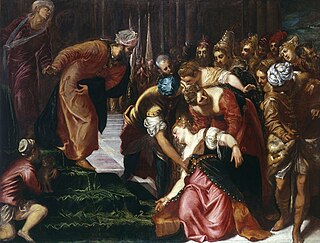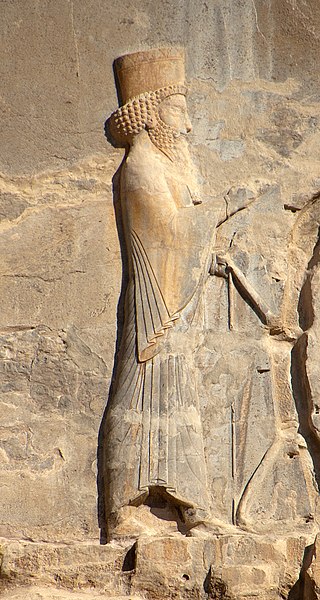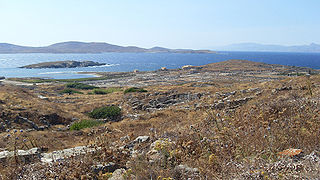Related Research Articles

Ahasuerus is a name applied in the Hebrew Bible to three rulers of Ancient Persia and to a Babylonian official in the Book of Tobit. It is a transliteration of either Xerxes I or Artaxerxes; both are names of multiple Achaemenid dynasty Persian kings.

Artaxerxes I was the fifth King of Kings of the Achaemenid Empire, from 465 to December 424 BC. He was the third son of Xerxes I.
Ctesias, also known as Ctesias of Cnidus, was a Greek physician and historian from the town of Cnidus in Caria, then part of the Achaemenid Empire.

Arses, known by his regnal name Artaxerxes II, was King of Kings of the Achaemenid Empire from 405/4 BC to 358 BC. He was the son and successor of Darius II and his mother was Parysatis.
Cleitarchus or Clitarchus was one of the historians of Alexander the Great. Son of the historian Dinon of Colophon, he spent a considerable time at the court of Ptolemy Lagus. He was active in the mid to late 4th century BCE.

Bardiya or Smerdis, also named as Tanyoxarces by Ctesias, was a son of Cyrus the Great and the younger brother of Cambyses II, both Persian kings. There are sharply divided views on his life. Bardiya either ruled the Achaemenid Empire for a few months in 522 BCE, or was impersonated by a magus called Gaumāta, whose name is given by Ctesias as Sphendadates, until he was toppled by Darius the Great.
Artabanus of Persia was a Persian political figure during the Achaemenid dynasty who was reportedly Regent of Persia for a few months.
Amestris was a Persian queen, the wife of Xerxes I of Persia, mother of Achaemenid King of Kings Artaxerxes I of Persia.
Parysatis was a Persian queen, consort of Darius II and had a large influence during the reign of Artaxerxes II.

The Achaemenid dynasty was a royal house that ruled the Persian Empire, which eventually stretched from Egypt and the Balkans in the west to Central Asia and the Indus Valley in the east.
Damaspia was a queen of Persia, wife of King Artaxerxes I, and mother of Xerxes II, his legitimate heir. She was Persian.
Amytis was an Achaemenid princess, daughter of king Xerxes I and queen Amestris, and sister of king Artaxerxes I.

Bibliotheca historica is a work of universal history by Diodorus Siculus. It consisted of forty books, which were divided into three sections. The first six books are geographical in theme, and describe the history and culture of Egypt, of Mesopotamia, India, Scythia, and Arabia (II), of North Africa (III), and of Greece and Europe (IV–VI). In the next section, he recounts human history starting with the Trojan War, down to the death of Alexander the Great. The last section concern the historical events from the successors of Alexander down to either 60 BC or the beginning of Caesar's Gallic War in 59 BC. He selected the name "Bibliotheca" in acknowledgement that he was assembling a composite work from many sources. Of the authors he drew from, some who have been identified include: Hecataeus of Abdera, Ctesias of Cnidus, Ephorus, Theopompus, Hieronymus of Cardia, Duris of Samos, Diyllus, Philistus, Timaeus, Polybius and Posidonius.
Meno, son of Alexidemus, was an ancient Thessalian political figure, probably from Pharsalus. He is famous both for the eponymous dialogue written by Plato and his role as one of the generals leading different contingents of Greek mercenaries in Xenophon's Anabasis.
Stateira was the wife of King Artaxerxes II of Persia.

The Wars of the Delian League were a series of campaigns fought between the Delian League of Athens and her allies, and the Achaemenid Empire of Persia. These conflicts represent a continuation of the Greco-Persian Wars, after the Ionian Revolt and the first and second Persian invasions of Greece.
There are numerous surviving ancient Greek and Latin sources on Alexander the Great, king of Macedon, as well as some Asian texts. The five main surviving accounts are by Arrian, Plutarch, Diodorus Siculus, Quintus Curtius Rufus, and Justin. In addition to these five main sources, there is the Metz Epitome, an anonymous late Latin work that narrates Alexander's campaigns from Hyrcania to India. Much is also recounted incidentally by other authors, including Strabo, Athenaeus, Polyaenus, Aelian, and others. Strabo, who gives a summary of Callisthenes, is an important source for Alexander's journey to Siwah.
Kourosh, also spelt Koroush, is a Persian male name common in Iran. Kourosh is composed of kouro- [sun] + -sh - [proprietorial suffix], meaning "Lord of the sun".
Darius, was crown prince of the Persian Empire. He was the eldest son of the Persian king Xerxes I and his wife Amestris, the daughter of Onophas. His younger brothers were Hystaspes and Artaxerxes, and his younger sisters were Rhodogyne and Amytis.
Persica is a lost Ancient Greek text, divided in 23 books, on Assyrian, Median and Persian history written by Ctesias of Cnidus, a physician at the court of the Persian king Artaxerxes II. The work's style and value for the study of the Achaemenid history have been a subject of much controversy among modern scholars.